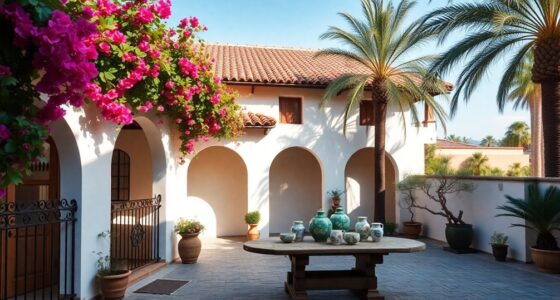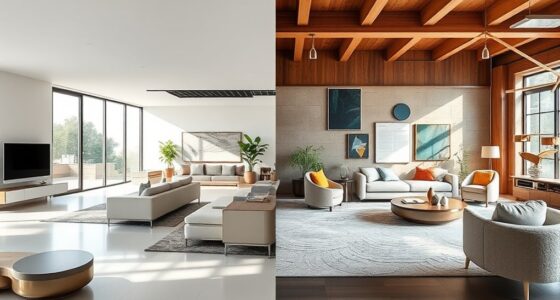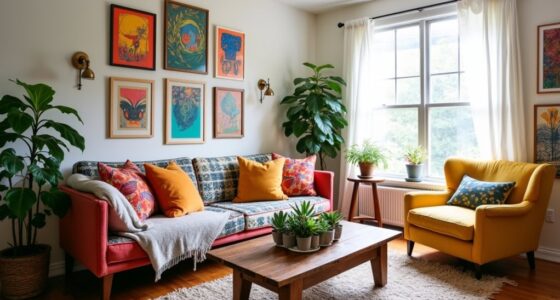The difference between classic and modern design lies in their core philosophies. Classic design embodies timeless elegance, focusing on ornate details, symmetry, and rich materials like marble and wood. It reflects cultural values and craftsmanship, ensuring a lasting impact. Modern design, on the other hand, prioritizes simplicity and functionality, characterized by clean lines and geometric shapes. This style embraces an open layout and natural materials, favoring minimalism over decoration. While classic spaces evoke history and tradition, modern spaces promote a more streamlined and practical approach. If you explore further, you'll uncover more fascinating insights into these distinct styles.
Key Takeaways
- Classic design emphasizes ornate details, symmetry, and historical references, while modern design focuses on simplicity, functionality, and clean lines.
- Classic interiors utilize rich materials like stone and wood, whereas modern design prioritizes eco-friendly materials and neutral color palettes.
- Classic spaces often feature intricate craftsmanship and traditional elements, while modern designs emphasize geometric shapes and open floor plans.
- Aesthetically, classic design embodies timeless elegance, resisting fleeting trends, while modern design embraces minimalism and practicality.
- Functionality in classic design may prioritize aesthetics, whereas modern design maximizes utility through multi-functional furniture and streamlined layouts.
Classic Design Overview
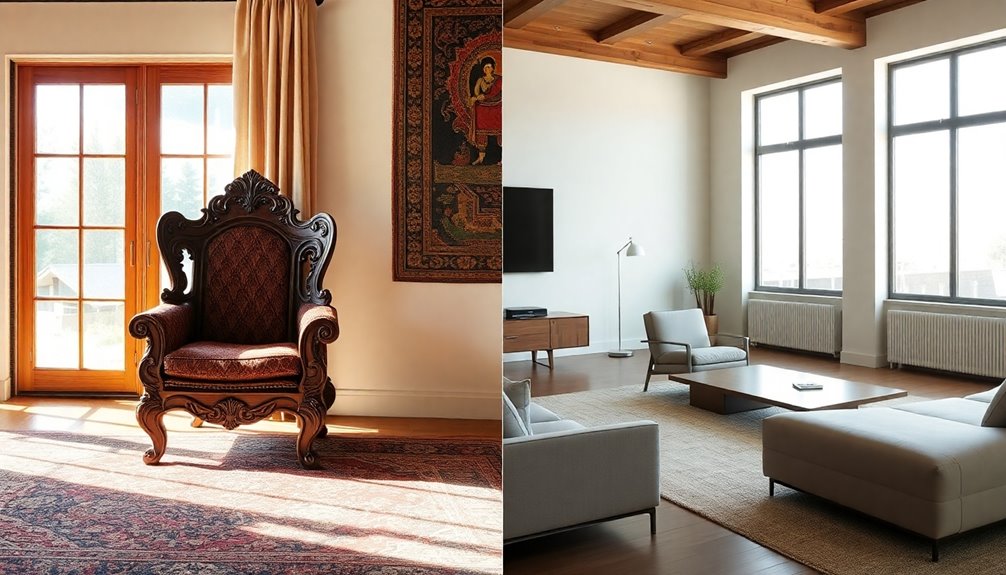
Classic design embodies a timeless aesthetic that resonates with balance and harmony.
You'll notice symmetry plays a crucial role, symbolizing stability and reflecting cultural values. The beauty lies in the clarity of form and function, steering clear of excessive ornamentation. Incorporating natural materials is essential, as these elements enhance both aesthetic appeal and structural integrity.
Natural materials like stone, marble, and wood enhance both aesthetic appeal and structural integrity, showcasing craftsmanship through traditional techniques like carving and molding. These elements create intricate details that captivate the eye, as seen in iconic structures like the Chartres Cathedral. Classic design often utilizes symbolic motifs that reflect cultural and philosophical beliefs, further enriching its narrative. Additionally, the use of natural materials in architecture not only promotes sustainability but also fosters a connection between the structure and its environment, allowing buildings to harmonize with their surroundings. An exploration of various design styles, including the spanish hacienda style design overview, reveals how distinct cultural influences shape architectural expression. Ultimately, these designs serve as a testament to human creativity and the timeless appeal of craftsmanship that resonates through generations.
Ultimately, classic design emphasizes simplicity and elegance, ensuring that its principles endure across time, inviting you to appreciate the artistry and cultural significance behind each carefully crafted piece.
Modern Design Overview
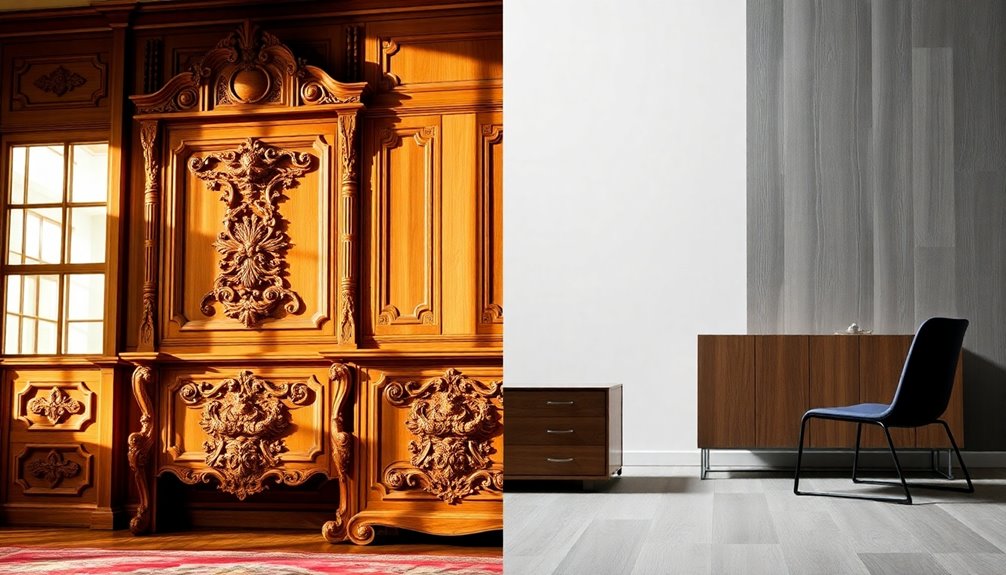
While classic design celebrates timeless elegance, modern design shifts the focus to simplicity and functionality.
You'll notice that modern design emphasizes clean lines and simple forms, prioritizing function over ornamentation. Geometric shapes dominate, while surfaces remain smooth with minimal decoration.
Natural materials like wood and stone, paired with a warm, earthy color palette, create a calming atmosphere. Open floor plans enhance the sense of space, allowing natural light to flood in through unadorned windows. This design respects the integrity of materials, showcasing their natural colors and textures, and often utilizes natural materials like leather and glass to enhance durability. Additionally, modern design often incorporates sustainable practices to promote environmental responsibility.
With a minimalist philosophy, modern design values uncluttered spaces and functional layouts, integrating technology seamlessly to enhance your living experience.
It's all about creating a serene, practical environment.
Key Characteristics of Classic Design
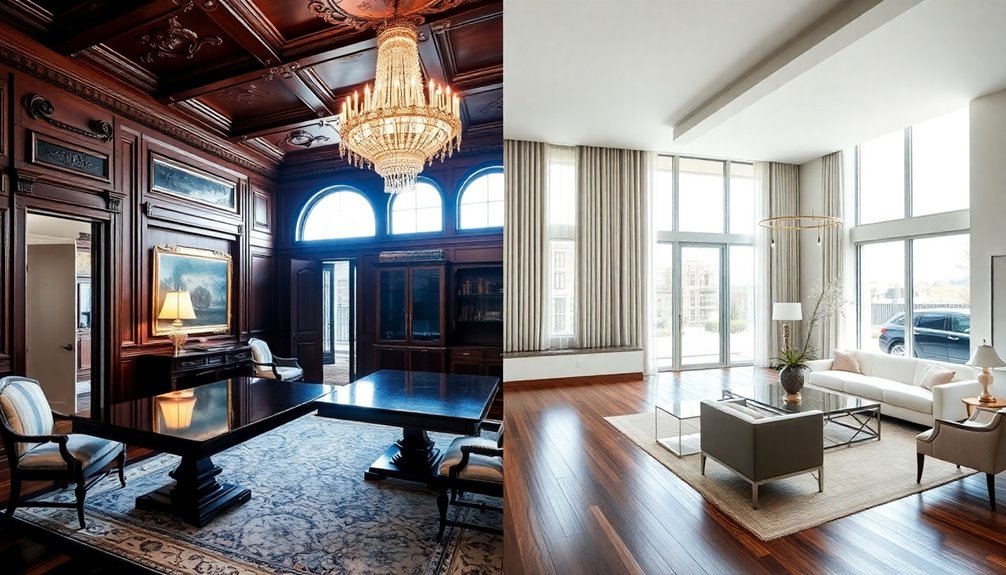
Timeless elegance defines the key characteristics of classic design, which prioritize symmetry, proportion, and intricate details.
You'll notice that symmetry serves as a central element, creating balance and harmony by mirroring furniture and architectural features. Proportion plays a vital role, establishing a logical flow that resonates with classical philosophy.
Traditional elements like columns and crown mouldings enhance the aesthetic, showcasing intricate patterns and craftsmanship. These details nod to history while appealing to modern tastes. Incorporating crown mouldings can further enhance the overall ceiling aesthetic, adding a touch of elegance that ties the space together.
Classic design boasts a timeless appeal, resisting fleeting trends and maintaining relevance across generations. Its iconic status ensures lasting demand, while quality materials and artistry contribute to its collectability and enduring presence.
Embracing these characteristics will elevate your space with sophistication and grace.
Key Characteristics of Modern Design
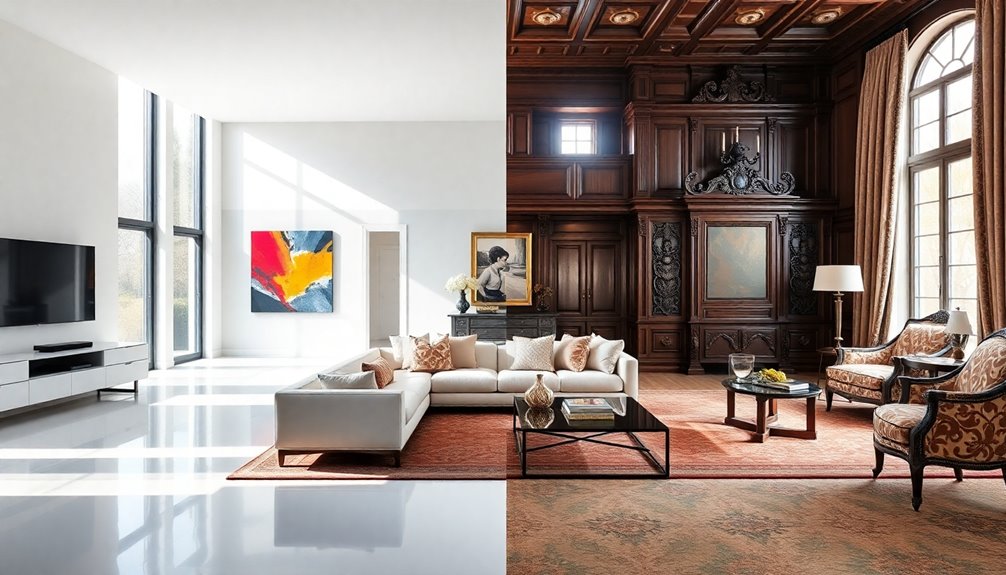
Modern design stands in stark contrast to its classic counterpart, focusing on simplicity and functionality.
You'll notice clean lines and minimalism that eliminate unnecessary elements, creating a sleek aesthetic. Geometric shapes and forms dominate, with open floor plans that enhance space flow. Pendant lights with rustic finishes can also be incorporated for a touch of warmth in modern spaces.
Multi-functional furniture is common, serving multiple purposes to maximize utility. The color palette is typically neutral, with occasional pops of color, complemented by textured finishes that add depth. Neutral tones are a defining feature of modern design, enhancing the minimalist aesthetic.
Natural and eco-friendly materials like wood, glass, and metal are prioritized. Above all, modern design emphasizes that form follows function, integrating technology seamlessly into the environment.
You'll find practical furniture that looks good while serving its purpose, making every space both beautiful and efficient.
Functionality and Aesthetics Comparison

In comparing functionality and aesthetics between classic and modern design, you'll find that each has its own unique approach.
Classic design often emphasizes ornate details and historical references, creating rich, luxurious interiors filled with natural materials and symmetrical layouts. While this adds elegance, it can sometimes prioritize aesthetics over practicality, as seen in complex drapery treatments. This style has become more accessible through mass production post-Industrial Revolution, maintaining its relevance in modern contexts.
On the other hand, modern design embraces a minimalist philosophy, focusing on simplicity and functionality. It features practical furniture made from industrial materials, promoting open spaces and clean lines.
Aesthetically, modern interiors use neutral color schemes with sleek accents and geometric forms, prioritizing a streamlined look. Ultimately, each style reflects different values in functionality and aesthetics, catering to distinct preferences.
Choosing Between Classic and Modern Design
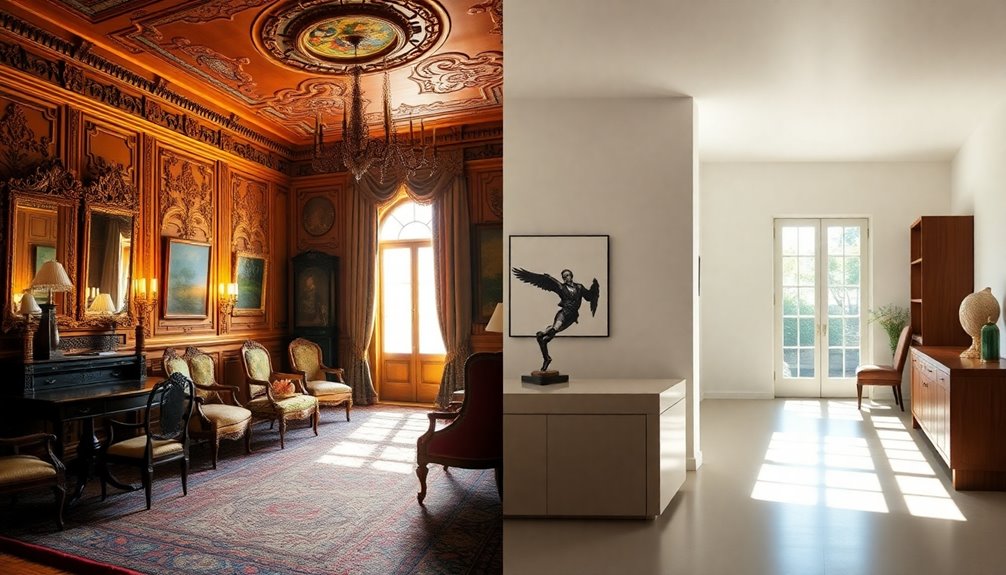
How do you decide between classic and modern design styles for your space? Start by assessing your style and the atmosphere you want to create. If you prefer a clean, minimalist look, modern design's neutral color schemes and functional furniture might suit you.
In contrast, if you appreciate warmth and rich details, classic design may be the way to go. Consider your home's architecture, too. Modern spaces thrive on open floor plans and large windows, while classic designs highlight ornate features and traditional elements. Additionally, natural light is a key component of modern design, allowing for bright and airy spaces that enhance the overall aesthetic.
Lastly, budget plays a role; modern designs often use more affordable materials, whereas classic designs may require richer, costlier options.
Ultimately, it's about what resonates with you and your lifestyle.
Frequently Asked Questions
How Do Classic and Modern Designs Influence Each Other?
Classic and modern designs influence each other in various ways.
You'll notice that modern designs often blend natural materials with innovative ones, creating a unique aesthetic.
Classic designs are evolving, incorporating more minimalist elements while retaining their intricate details.
Functionality plays a crucial role too, as both styles strive for a balance between beauty and utility.
This dynamic interaction allows you to mix and match elements, resulting in versatile and timeless interior spaces.
What Are Some Famous Examples of Classic Design?
When you explore famous examples of classic design, you'll encounter iconic pieces like the Wassily Armchair and the Bialetti Moka Express.
These creations showcase timeless appeal and innovative materials, making them significant in design history.
The Chanel 2.55 Handbag and the Coca-Cola Bottle also stand out, illustrating how classic designs evoke emotions and reflect cultural values.
You'll appreciate how these items have remained relevant and cherished over generations, embodying lasting beauty and functionality.
Can Modern Design Include Traditional Elements?
Yes, modern design can absolutely include traditional elements!
You can seamlessly blend materials like reclaimed wood or stone with contemporary aesthetics. Consider incorporating traditional patterns in textiles or using architectural features like arches for added elegance.
How Do I Maintain Classic Furniture?
Maintaining classic furniture is like tending to a cherished garden; it requires care and attention.
Start by dusting regularly with a soft cloth to keep dirt at bay. When cleaning, use a mild soap solution and always test products on a hidden area first.
Avoid harsh chemicals that might harm the finish. Finally, polish monthly to enhance the wood's natural beauty, ensuring your treasured piece thrives for generations to come.
What Styles Blend Well With Modern Design?
If you're looking to blend styles with modern design, consider mid-century modern for its neutral palette and functional furniture.
Scandinavian design adds a minimalist aesthetic and emphasizes natural light.
Industrial elements, like exposed materials and open spaces, enhance modern simplicity.
Finally, coastal decor introduces light colors and natural textures, creating an airy feel.
Each of these styles complements modern design, maintaining a focus on functionality and simplicity while adding unique character.
Conclusion
In choosing between classic and modern design, think of it like selecting a timeless book or a trendy magazine. Classic design brings a sense of history and elegance, while modern design offers sleek simplicity and innovation. Your choice should reflect your personal style and the atmosphere you want to create. Whether you lean towards the warmth of classic or the freshness of modern, remember that your space should feel like home, no matter the era.


